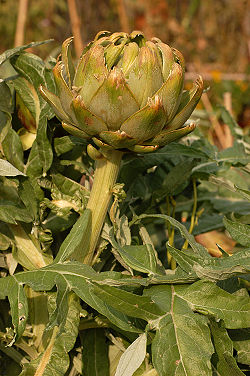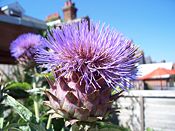Artichoke
| Artichoke | ||||||||||||||
|---|---|---|---|---|---|---|---|---|---|---|---|---|---|---|
 |
||||||||||||||
| Scientific classification | ||||||||||||||
|
||||||||||||||
| Binomial name | ||||||||||||||
| Cynara cardunculus L.[1] |
||||||||||||||
| Synonyms | ||||||||||||||
|
Cynara scolymus L.[1] |
The Globe Artichoke (Cynara cardunculus)[1] is a perennial thistle originating in southern Europe around the Mediterranean. It grows to 1.5-2 m tall, with arching, deeply lobed, silvery glaucous-green leaves 50–80 cm long. The flowers develop in a large head from an edible bud about 8–15 cm diameter with numerous triangular scales; the individual florets are purple. The edible portion of the buds consists primarily of the fleshy lower portions of the involucral bracts and the base, known as the "heart"; the mass of immature florets in the center of the bud is called the "choke". These are inedible in older larger flowers.
Contents |
Cultivation
The origin of artichokes is unknown, though they are said to have come from the Maghreb (North Africa), where they are still found in the wild state. The seeds of artichokes, probably cultivated, were found during the excavation of Mons Claudianus in Egypt (Roman period. Source: Vartavan, C. (de) and Asensi Amoros, V. 1997 Codex of Ancient Egyptian Plant Remains. London, Triade Exploration. Page 91). In the Arab world they are known as Ardi-Shoki (ارضي شوكي) which means "ground thorny". The cardoon, a naturally occurring variant of the same species, is native to the Mediterranean, even though it has not been mentioned in Classic literature. Artichokes were cultivated in Sicily during the Greek occupation, the Greeks calling them kaktos. In this period the leaves and flowerheads, which cultivation had already improved from the wild form, were eaten. The Romans, who called the vegetable carduus received the plant from the Greeks. Further improvement in the cultivated form appear to have taken place in the Muslim period in the Maghreb, although the evidence is inferential only.[2]

Globe artichokes are known to have been cultivated at Naples around the middle of the 9th century. Modern scholar, Le Roy Ladurie, in his book Les Paysans de Languedoc has documented the spread of the artichoke:
"The blossom of the thistle, improved by the Arabs, passed from Naples to Florence in 1466, carried by Phillippo Strozzi. Towards 1480 it is noticed in Venice, as a curiosity. But very soon veres towards the north-west...Artichoke beds are mentioned in Avignon by the notaries from 1532 onward; from the principle towns they spread into the hinterlands...[appearing as carchofas at Cavaillon in 1541, at Chateauneuf du Pape in 1553, at Orange in 1554. The local name remains carchofas, from the Italian carciofo...They are very small, the size of a hen's egg...and are still considered a luxury, a vaguely aphrodisiac tidbit which one preserved in sugar syrup."[3]
The Dutch introduced artichokes to England, where they grew in Henry VIII's garden at Newhall in 1530. They were brought to the United States in the 19th century, to Louisiana by French immigrants and to California by Spanish immigrants. The name has originated from the Arabic al-kharshof, through a Northern Italian dialect word, articiocco.[4]
| Artichoke, cooked boiled, salted Nutritional value per 100 g (3.5 oz) |
||||||||||||||||||||||||||||||||||||||
|---|---|---|---|---|---|---|---|---|---|---|---|---|---|---|---|---|---|---|---|---|---|---|---|---|---|---|---|---|---|---|---|---|---|---|---|---|---|---|
| Energy 50 kcal 220 kJ | ||||||||||||||||||||||||||||||||||||||
|
||||||||||||||||||||||||||||||||||||||
| Percentages are relative to US recommendations for adults. Source: USDA Nutrient database |
||||||||||||||||||||||||||||||||||||||
Today, Globe Artichoke cultivation is concentrated in the countries bordering the Mediterranean basin. The main producers are Italy, Spain, and France. In the United States, California provides nearly 100% of the U.S. crop, and approximately 80 percent of that is grown in Monterey County; there, Castroville proclaims itself to be "The Artichoke Center of the World", and holds an annual festival at which artichoke ice cream is served. The cultivar 'Green Globe' is virtually the only kind grown commercially in the U.S.
Artichokes can be produced from seeds or from vegetative means such as division, root cuttings or micropropagation. Though technically perennials which normally produce the edible flower only during the second and subsequent years; certain varieties from seed can be grown as annuals, producing a limited harvest at the end of the first growing season, even in regions where the plants are not normally winter hardy. This means that home gardeners in northern regions can attempt to produce a crop without the need to overwinter plants with special treatment or protection. The recently introduced seed cultivar 'Imperial Star' has been bred to produce in the first year without such measures. An even newer cultivar, 'Northern Star', is said to be able to overwinter in more northerly climates, and readily survive sub-zero temperatures. [5]
Commercial culture is limited to warm areas in USDA hardiness zone 7 and above. It requires good soil, regular watering and feeding plus frost protection in winter. Rooted suckers can be planted each year so that mature specimens can be disposed of after a few years, as each individual plant only lives a few years. The peak season for artichoke harvesting is the spring, but they continue to be harvested throughout the summer, with another peak period in mid autumn.
When harvesting, they are cut from the plant so as to leave an inch or two of stem. Artichokes possess good keeping qualities, frequently remaining quite fresh for two weeks or longer under average retail conditions.
Apart from food use, the Globe Artichoke is also an attractive plant for its bright floral display, sometimes grown in herbaceous borders for its bold foliage and large purple flowerheads.
Varieties
- Traditional cultivars (Vegetative multiplication)
- Green color, big size: Camus de Bretagne, Castel (France), Green globe (USA).
- Green color, medium size: Blanca de Tudela (Spain), Argentina, Española (Chile), Blanc d'Oran (Algeria), Sakiz, Bayrampsha (Turkey).
- Purple color, big size: Romanesco, C3 (Italy).
- Purple color, medium size: Violet de Provence (France), Brindisino, Catanese (Italy), Violet d'Algerie (Algeria), Baladi (Egypt).
- Spined: Spinoso sardo (Italy), Criolla (Peru).
- Varieties multipled by seeds
Uses

Cooking
In the US, whole Globe Artichokes are most frequently prepared for cooking by removing all but 5–10 mm or so of the stem, and (optionally) cutting away about a quarter of each scale with scissors. This removes the thorns that can interfere with handling the leaves when eating. Then, the artichoke is boiled or steamed until tender. If boiling, salt can be added to the water, if desired. It may be preferable not to cover the pot while the artichokes are boiled, so that the acids will boil out into the air.

Covered artichokes can turn brown due to the acids and chlorophyll oxidation. Leaves are often removed and eaten one at a time, sometimes dipped in vinegar, butter, mayonnaise, aioli, lemon juice or other sauces.
In France artichokes are very popular deep fried. In Italy artichoke hearts in oil are the usual vegetable for spring in the 'Four Seasons' pizza (with olives for summer, mushrooms for autumn and prosciutto for winter).[6]. In Spain, the more tender younger and smaller artichokes are used. They can be sprinkled with olive oil and left in hot ashes in a barbecue, sauteed in olive oil with garlic, or sauteed and combined with eggs in a tortilla (frittata). More often cited are the Greek artichokes (a la polita), of which probably the finest examples are to be found on the island of Tinos.
The heart of the artichoke is also eaten.
Artichoke stems, which are often thrown away, are perfectly edible and taste like the artichoke heart.
Tea

Artichokes can also be made into an herbal tea; artichoke tea is produced as a commercial product in the Dalat region of Vietnam.photo[2]
Liquor
Artichoke is the primary flavor of the Italian liqeur Cynar.
Medical Uses
Dried or fresh leaves and/or stems of Cynara are used to increase bile production. Cynarin, an active constituent in Cynara, causes an increase in bile flow.[7]
References
- ↑ 1.0 1.1 1.2 "Cynara cardunculus information from NPGS/GRIN". www.ars-grin.gov. Retrieved on 2008-04-13.
- ↑ Watson, Andrew. Agricultural innovation in the early Islamic world. Cambridge University Press. p.64
- ↑ Ketcham Wheaton, Barbara, "Savoring the Past", (Touchstone Books, 1983) pp. 66-67
- ↑ OED:Artichoke
- ↑ [1] Peters Seed and Research
- ↑ Four Seasons Pizza Recipes at Cooking.com
- ↑ CAB Abstracts
- This article incorporates text from the public domain 1911 edition of The Grocer's Encyclopedia.